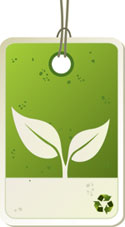Perhaps you have wondered (I certainly have), about the environmental impact of bleach – does it pose a danger to the environment and is it okay to use? We’re talking about household bleach, usually with the name Clorox on the bottle, virtually always seen as a gallon jug. This stuff is used in large quantities because people like things to be disinfected and white.
Household liquid bleach is water and approximately five percent sodium hypochlorite; the powdered stuff, like Comet, is calcium hypochlorite; the gas, produced for industrial uses or resulting from mixing bleach and other chemicals, is chlorine.
Sodium hypochlorite (household bleach) mostly breaks down in the environment. It can be used for emergency water purification for drinking (a drop or a few per quart). Household bleach is dangerous when mixed with ammonia, acids or many of the other ingredients found in cleaning products – producing toxic chlorine gas or volatile organic compounds. Bleach should also be highly diluted for cleaning and disinfecting, for example: one part bleach to fifty parts water, and used in a well-ventilated area
Industrial chlorine has many industrial uses and is another story. The gas produced for industry has a variety of uses. The most common use is in the highly toxic production of PVC (polyvinyl chloride) plastics and pesticides, or in the bleaching of paper and textiles. Organochlorines are the chemicals produced when organic materials (carbon based) come in contact with chlorine. More than 11,000 are made purposefully and even more are environmental byproducts. These chemicals persist in the environment, and bioacccumulate in animal (including human) fat tissues. DDT, outlawed in most countries, is one of these.
While bleach can be a useful in the home and beneficial when used sparingly, overall, chorine bleaches are not very friendly substances, particularly when compared to alternatives such as “oxygen” bleach (hydrogen peroxide, a stronger solution than the stuff in the brown bottles) or percarbonate bleaches which are effective clothing whiteners that are less damaging to fabric than the chlorine variety.
Other non-toxic alternatives to bleach that work as household cleansers include:
> Lemon juice and peroxide mixed together.
> Baking powder for scrubbing.
> Vinegar for cleansing and disinfecting (vinegar kills most bacteria, mold and fungi and other microbes)
> Tea tree oil for disinfecting.
> Borax for cleansing, whitening and disinfecting.
And anyway, why does everything have to be so WHITE?
bt.cdc.gov/disasters/bleach.asp
thegoodhuman.com/2009/07/22/eco-friendly-alternatives-to-bleach
Sign up to receive a short and sweet weekly ecofact: sustainability.ucsb.edu.
Chlorine-free nontoxic bleach alternatives.
These can be used for household cleaning and laundry:
Bi-O-Kleen Oxygen Bleach Plus’ active ingredient is sodium percarbonate with degrades into environmentally-friendly oxygen, water and natural soda ash: biokleenhome.com.
Oxo Brite Non-Chlorine Bleach by Earth Friendly Products is made up of sodium percarbonate and sodium carbonate. Petroleum-
free: ecos.com.
Ecover Non-Chlorine Bleach, approved by the Vegan Society, made of percarbonate (salt, limestone and oxygenated water): ecover.com.
Seventh Generation Chlorine Free Bleach, one of the primary ingredients is oxygen safe bleach: seventhgeneration.com.
Thanks to the Good Human for these suggestions.

